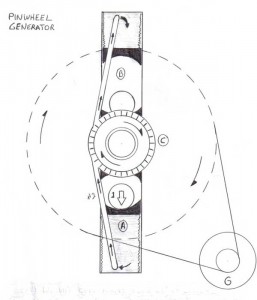 Pinwheels
have been used for many things along history. One of the most
interesting uses I’ve ever seen is making a pinwheel act as a free
energy generator, powered by gravity.
Pinwheels
have been used for many things along history. One of the most
interesting uses I’ve ever seen is making a pinwheel act as a free
energy generator, powered by gravity.I really don’t guarantee whether it will work or not, but I’m eager to find anybody who tried it and their results. Gravity is one of the disputed possible sources of energy that, if harvested properly and if working, would change the way we see things – forever.
So, here’s how the pinwheel generator supposedly works:
“As the weight ball in the lower cylinder descends, it forces the liquid out of the cylinder, through the Pelton wheel (turning the wheel and the generator), and into the upper cylinder. As the ball nears the bottom of the cylinder, the liquid weight of the mechanism is concentrated in the upper and right side cylinders, over-balancing the mechanism to rotate to the right when unlocked.
As the ball presses down on the unlocking mechanism, it also compresses the push bar spring. If the ball weighs 60,000 lbs, the energy in the spring can equal 59,999 lbs. Once the ball unlocks the mechanism, the spring bar pushes the lower cylinder out of the stop block. This push, along with the over-balance, causes the whole mechanism to rotate 90 degrees to where the right side cylinder becomes the lower cylinder, having now its ball begin its descent-producing electricity.
This process continues perpetually. An air venting pipe connects the cylinders that are opposite to each other so that as the liquid enters the top cylinder, the air it is displacing goes out the pipe and into the bottom cylinder, being assisted by the vacuum being created in the bottom cylinder by it’s ball descending.
This mechanism can function because the laws of entropy prevent only singular mechanisms from performing perpetually because they need to use the energy they produce to recycle themselves. Being a compound mechanism, this generator does not. The energy is generated, gravity rotates it.”
If any of you tried this experiment and it did or did not work, please comment. Also, if you have an opinion after seeing the schematics presented below, say your thoughts.
There are several problems with this. The description of how the machine operates is hard to follow, so I will describe how I understand it:
ReplyDeleteThe machine begins in the upright position~ as in the diagram. The bottom cylinder is full of water. The weight of the ball displaces the water, which exits the cylinder via a tube. The displaced water enters a hydraulic motor around the fulcrum of the device, which rotates the device 90 degrees. As the water flows through the motor, it fills the second cylinder, which was initially in the top position. The weight of the water causes the device to rotate an additional 90 degrees. The cycle repeats from there.
The force used to generate hydraulic pressure to turn the motor comes from the weight of the ball. Because the motor is at the fulcrum of a lever, essentially, the force required to rotate the device will always be greater that the force generated by the ball ( the force required is weight x distance of center of gravity from fulcrum~ a torque situation). This is because the center of gravity of the device begins near the bottom and stays there, because a) the ball can only displace the water if it weighs more than the water, b) the top ball starts off in its nearest position relative to the fulcrum, and c) the bottom ball moves away from the fulcrum as it displaces water, which would increase the force required to lift it by rotation at the fulcrum.
If this machine was built, the lower ball would not displace the water, because the flow would be stopped at the motor. The weight of the ball cannot generate the water pressure required to lift itself when the center of gravity is any distance below the fulcrum. Really, when losses are included~ energy lost as heat during water pressurization, as well as the friction of the fulcrum axle and load of the generator~ the weight of an object could never create the pressure required to move itself, in any scenario.